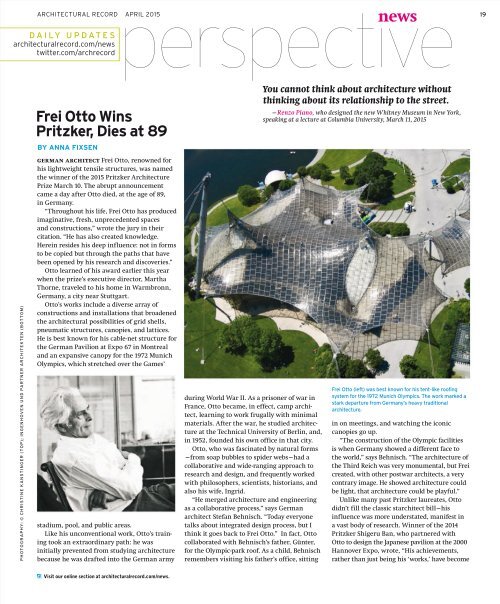Architectural Record 2015-04
You also want an ePaper? Increase the reach of your titles
YUMPU automatically turns print PDFs into web optimized ePapers that Google loves.
ARCHITECTURAL RECORD APRIL <strong>2015</strong><br />
news<br />
twitter.com/archrecordperspective<br />
DAILY UPDATES<br />
architecturalrecord.com/news<br />
19<br />
PHOTOGRAPHY: © CHRISTINE KANSTINGER (TOP); INGENHOVEN UND PARTNER ARCHITEKTEN (BOTTOM)<br />
Frei Otto Wins<br />
Pritzker, Dies at 89<br />
BY ANNA FIXSEN<br />
german architect Frei Otto, renowned for<br />
his lightweight tensile structures, was named<br />
the winner of the <strong>2015</strong> Pritzker Architecture<br />
Prize March 10. The abrupt announcement<br />
came a day after Otto died, at the age of 89,<br />
in Germany.<br />
“Throughout his life, Frei Otto has produced<br />
imaginative, fresh, unprecedented spaces<br />
and constructions,” wrote the jury in their<br />
citation. “He has also created knowledge.<br />
Herein resides his deep influence: not in forms<br />
to be copied but through the paths that have<br />
been opened by his research and discoveries.”<br />
Otto learned of his award earlier this year<br />
when the prize’s executive director, Martha<br />
Thorne, traveled to his home in Warmbronn,<br />
Germany, a city near Stuttgart.<br />
Otto’s works include a diverse array of<br />
constructions and installations that broadened<br />
the architectural possibilities of grid shells,<br />
pneumatic structures, canopies, and lattices.<br />
He is best known for his cable-net structure for<br />
the German Pavilion at Expo 67 in Montreal<br />
and an expansive canopy for the 1972 Munich<br />
Olympics, which stretched over the Games’<br />
stadium, pool, and public areas.<br />
Like his unconventional work, Otto’s training<br />
took an extraordinary path: he was<br />
initially prevented from studying architecture<br />
because he was drafted into the German army<br />
during World War II. As a prisoner of war in<br />
France, Otto became, in effect, camp architect,<br />
learning to work frugally with minimal<br />
materials. After the war, he studied architecture<br />
at the Technical University of Berlin, and,<br />
in 1952, founded his own office in that city.<br />
Otto, who was fascinated by natural forms<br />
—from soap bubbles to spider webs—had a<br />
collaborative and wide-ranging approach to<br />
research and design, and frequently worked<br />
with philosophers, scientists, historians, and<br />
also his wife, Ingrid.<br />
“He merged architecture and engineering<br />
as a collaborative process,” says German<br />
architect Stefan Behnisch. “Today everyone<br />
talks about integrated design process, but I<br />
think it goes back to Frei Otto.” In fact, Otto<br />
collaborated with Behnisch’s father, Günter,<br />
for the Olympic-park roof. As a child, Behnisch<br />
remembers visiting his father’s office, sitting<br />
You cannot think about architecture without<br />
thinking about its relationship to the street.<br />
—Renzo Piano, who designed the new Whitney Museum in New York,<br />
speaking at a lecture at Columbia University, March 11, <strong>2015</strong><br />
Frei Otto (left) was best known for his tent-like roofing<br />
system for the 1972 Munich Olympics. The work marked a<br />
stark departure from Germany’s heavy traditional<br />
architecture.<br />
in on meetings, and watching the iconic<br />
canopies go up.<br />
“The construction of the Olympic facilities<br />
is when Germany showed a different face to<br />
the world,” says Behnisch. “The architecture of<br />
the Third Reich was very monumental, but Frei<br />
created, with other postwar architects, a very<br />
contrary image. He showed architecture could<br />
be light, that architecture could be playful.”<br />
Unlike many past Pritzker laureates, Otto<br />
didn’t fill the classic starchitect bill—his<br />
influence was more understated, manifest in<br />
a vast body of research. Winner of the 2014<br />
Pritzker Shigeru Ban, who partnered with<br />
Otto to design the Japanese pavilion at the 2000<br />
Hannover Expo, wrote, “His achievements,<br />
rather than just being his ‘works,’ have become<br />
Visit our online section at architecturalrecord.com/news.


















